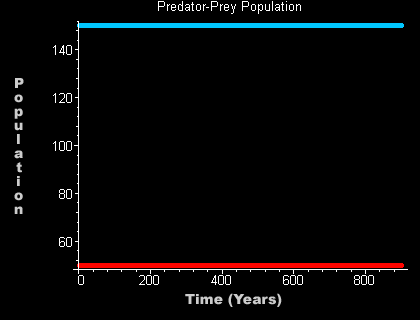Equilibrium Points
Finding equilibrium points for the predators and the prey.
An equilibrium point for a population model is defined as the population sequence reaching a balanced state, meaning that the populations remain constant after a certain point in time. Finding the equilibrium point is crucial to developing a balanced model in which the predator and prey will live
indefinitely. If each population starts at its equilibrium point then the populations will never become
extinct or grow unbounded.
The equilibrium equation is Pn-1 = (1 + a) * Pn-1, where
Pn = Pn-1.
To find the equilibrium point, substitute x for every Pn-1 in the Lotka-Volterra model equations. Since we have two variables, substitute y for the Qn-1.
This gives us, x = (1 + a) ( x ) - ( bxy ) and y = (1 - d) ( y ) + ( cxy ). Solve the resulting equations for x and the other for y.
x = (1 + a)(x) - bxy
x = x ((1 + a) - by)
1 = (1 + a) - by
by = (1 + a) - 1
by = a
y = a/b;
y = (1 - d)(y) + cxy
y = y ((1 - d) + cx)
1 = (1 - d) + cx
cx = 1 - (1 - d)
cx = 1 - 1 + d = d
x = d/c;
|
Now, converting the variables back, x = Pn and y =
Qn. The equilibrium point for the predators is a/b and the E.P. for the prey is
d/c.
Plugging these points as the initial populations we get two constant growths as expected.
When viewing the same initial population in the phase plot, we see the same constant point. Notice that the equilibrium point presented here is the center of the previous phase plot.
|




